“Yoga is the journey of the self, through the self, to the self.” – Bhagavad Gita.
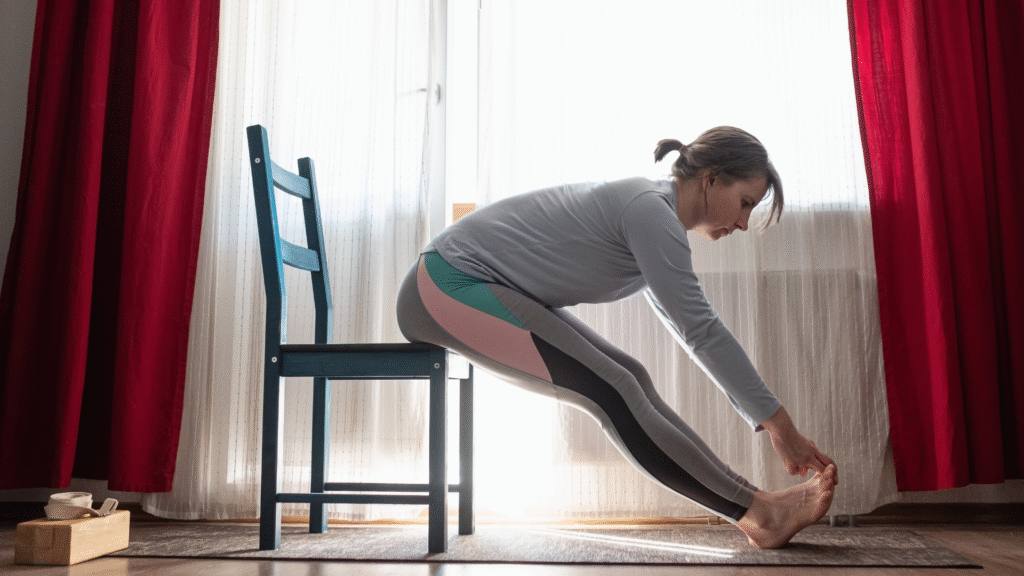
Bending, stretching, and flowing movements done on a mat are what people think yoga is. But the truth is: yoga does not have to be complicated, or limited to those who can twist like pretzels. From seniors and beginners to office workers and individuals with limited mobility, chair yoga makes yoga accessible for anyone.
It is an effective practice that helps improve posture, strengthen your core, reduce stress, and boost overall well-being while sitting in a chair.
Whether you’re looking for yoga for beginners, yoga for seniors, or an easy way to move during your work, this blog will tell you everything you need to know about chair yoga.
Table of Contents
- Introduction: Why Chair Yoga Matters
- What Is Chair Yoga?
- Benefits of Chair Yoga Backed by Science
- Who Can Practice Chair Yoga?
- Seniors
- Beginners
- Office Workers
- People with Limited Mobility
- Safety Tips & Posture Guidelines
- Step-by-Step Chair Yoga Poses to Improve Posture & Core Strength
- Seated Mountain Pose
- Seated Cat-Cow Stretch
- Seated Forward Bend
- Seated Spinal Twist
- Seated Side Stretch
- Seated Leg Lifts
- Seated Eagle Arms
- Seated Warrior II Variation
- Seated Bridge with Support
- Relaxation & Breathing Exercise
- How to Build a Simple Daily Routine with Chair Yoga
- Real-Life Applications: Using Chair Yoga at Home, Office & Senior Centers
- Lifestyle Tips to Support Posture & Core Strength
- Common Mistakes to Avoid in Chair Yoga
- FAQs
- Conclusion & Call-to-Action
2. What Is Chair Yoga?
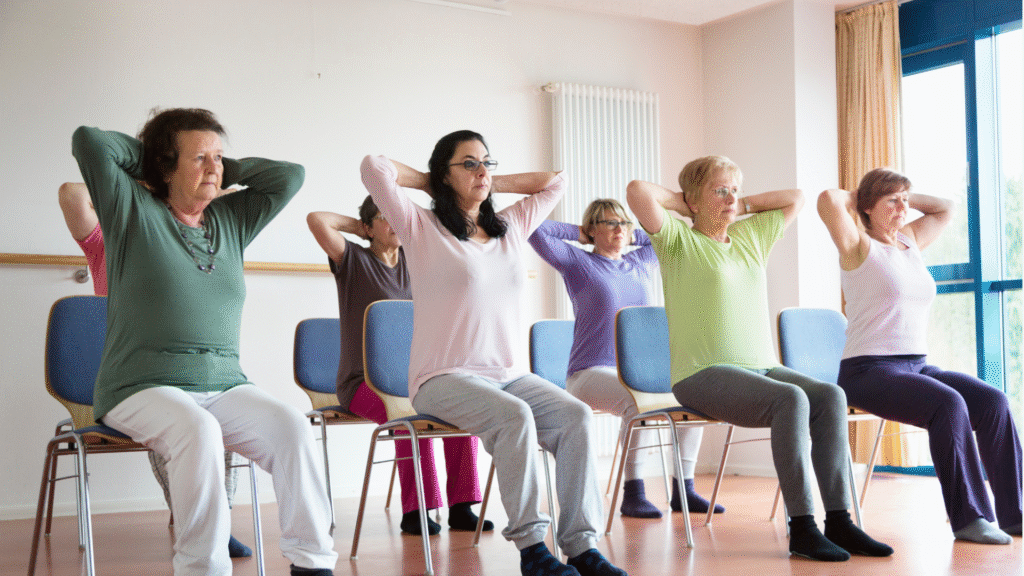
Chair yoga is a gentle form of yoga that consists of traditional poses that you can do while sitting on a chair or by using a chair for support. Unlike floor-based yoga, it removes barriers such as flexibility, balance, or mobility limitations, which makes it an accessible practice for nearly everyone.
Participants remain seated for most of the practice instead of lying on a mat. For stability, some movements may involve standing while holding a chair, but comfort, safety, and ease of movement arethe main focus.
You can achieve a lot of benefits, such as posture improvement, core strength, stress relief, and flexibility. You can do it in your living room, at your desk, or even while traveling.
3. Benefits of Chair Yoga Backed by Science
Yoga is the exercise of the mind and body, and research shows that even chair yoga offers proven health benefits.
Physical Benefits
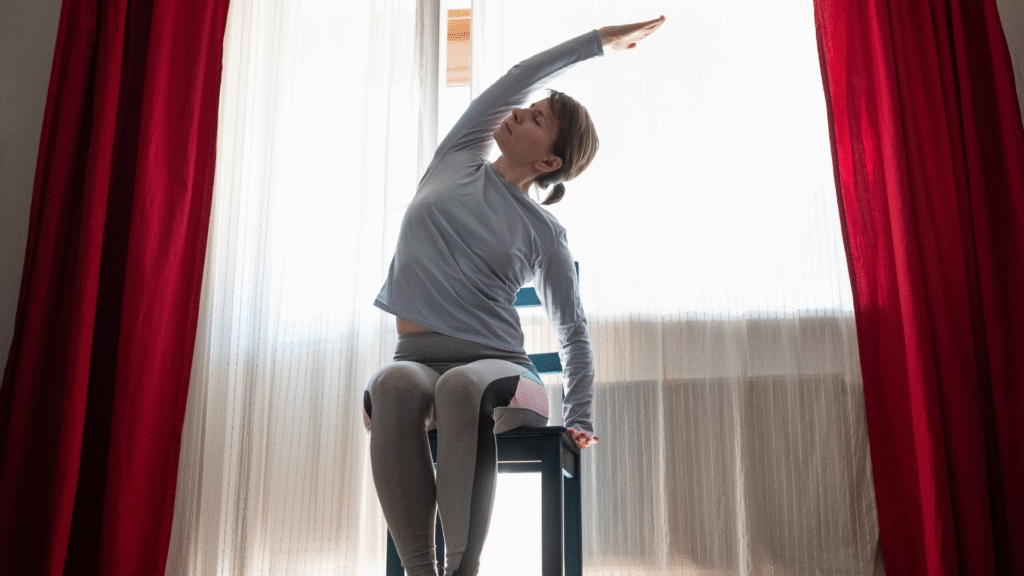
- Improves Posture: Many chair yoga exercises give strength to spinal muscles, which reduces back pain.
- Builds Core Strength: During seated poses like leg lifts or twists, core muscles engage, which gives balance.
- Increases Flexibility: Stretching arms, shoulders, and legs may enhance the range of motion.
- Supports Joint Health: Safe movements keep joints mobile, which is beneficial for seniors.
- Boosts Circulation: Seated stretches improve blood flow.
Mental & Emotional Benefits
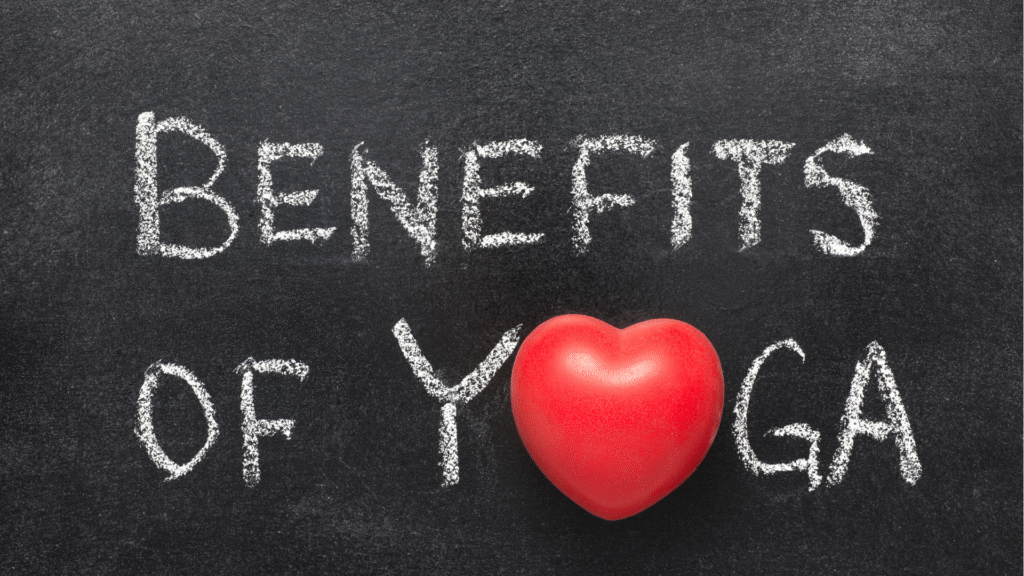
- Reduces Stress: Controlled breathing and mindful movement can help with relaxation.
- Improves Focus: To reset the mind and increase productivity, chair yoga can be done during work breaks.
- Enhances Mood: Studies show yoga may reduce symptoms of anxiety and depression.
Evidence from Studies
- A 2017 study published in the Journal of Gerontological Nursing found that in older adults with osteoarthritis, chair yoga improved pain management and mobility.
- Research in Complementary Therapies in Medicine (2020) showed thatchair yoga reduced stress and improved productivity in office workers.
- A clinical trial in the International Journal of Yoga (2019) noted that in seniors, chair yoga boosted balance and functional mobility.
4. Who Can Practice Chair Yoga?
One of the most beautiful aspects of chair yoga is that anyone can practice it. Unlike traditional yoga, which may require floor work, deep flexibility, or advanced balance.
Let’s break down the groups who benefit most from chair yoga:
Seniors
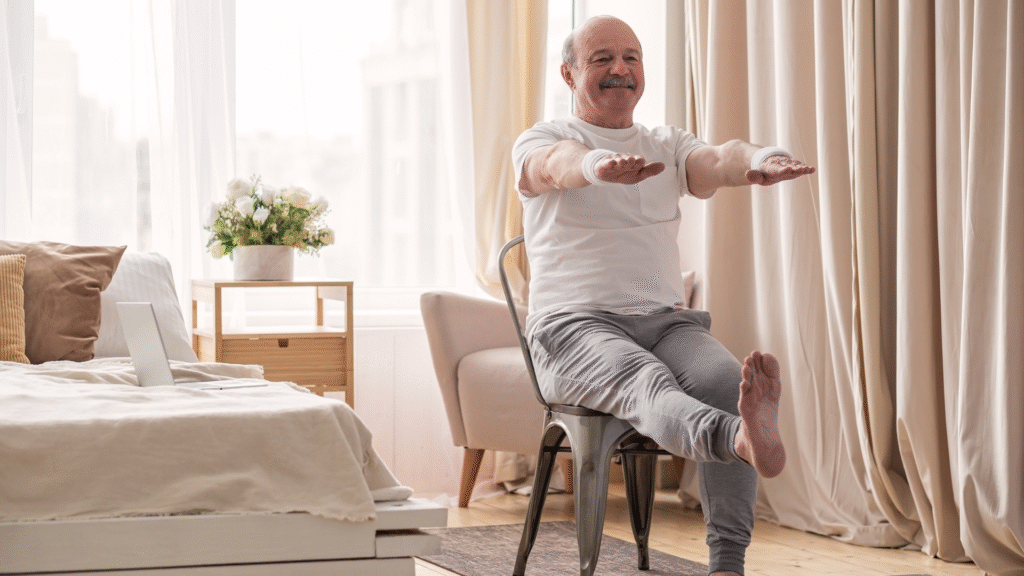
Older adults can:
- Improve joint mobility and reduce stiffness.
- Strengthen muscles.
- To boost lung capacity, practice breathing techniques.
- Improve posture, reducing common issues like rounded shoulders or back pain.
Beginners
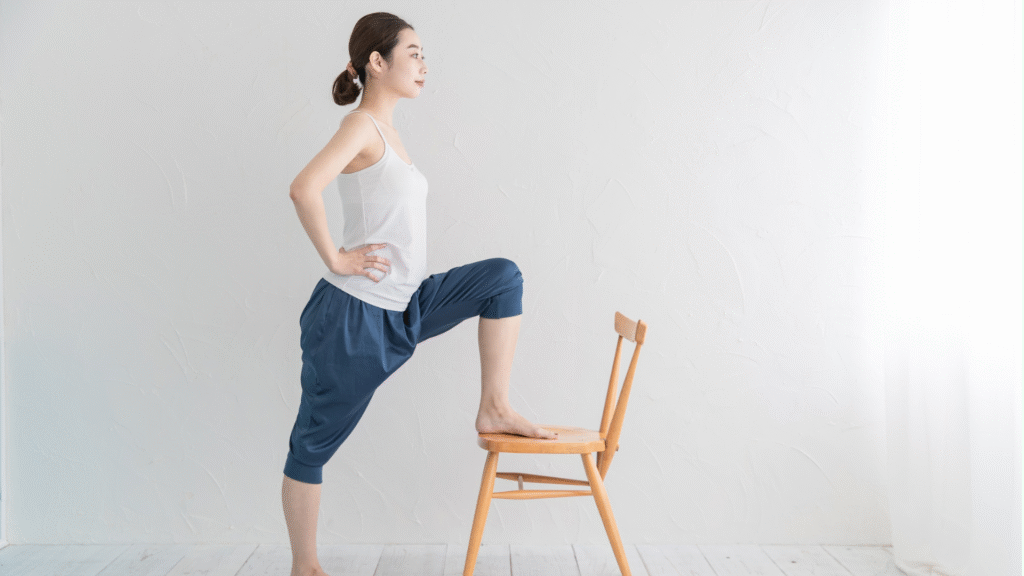
Chair yoga is the perfect entry point for people who have never tried yoga because it:
- Uses a chair to provide comfort.
- Reduces the risk of injury.
- If desired, it builds confidence before transitioning to mat-based yoga.
Office Workers

Sitting for hours at a desk is one of the biggest posture killers, and this can lead to:
- Rounded shoulders.
- Tight hip flexors.
- Back and neck pain.
- Reduced core strength.
Chair yoga is a practical solution for office workers because it can be done without leaving your desk.
People with Limited Mobility
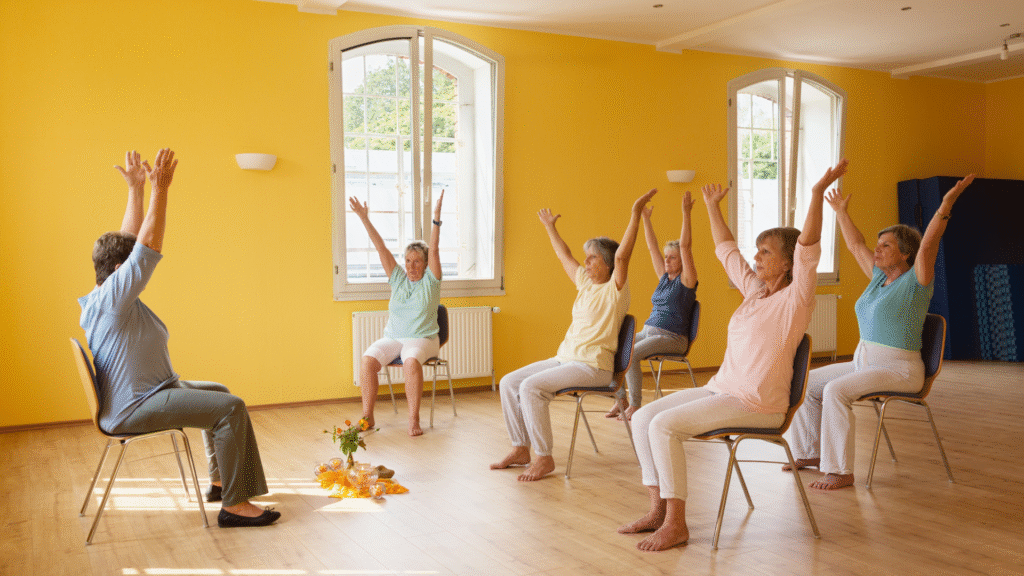
Chair yoga is particularly beneficial for individuals recovering from injury, living with chronic conditions, or experiencing physical limitations. It offers:
- A safe way to stay active without prolonged standing.
- Based on ability, modified poses can be adjusted.
- Through gentle movement, increased confidence and independence.
- Stress reduction and a sense of accomplishment.
5. Safety Tips & Posture Guidelines
Following these guidelines will help you avoid injury and give you benefits from your practice:
Choose the Right Chair
- Use a stable, sturdy chair (no wheels or wobbling).
- Flat seat, preferably without arm.
- Feet should rest flat on the floor with knees at 90°.
- If needed, add a cushion or blanket for comfort.
Listen to Your Body
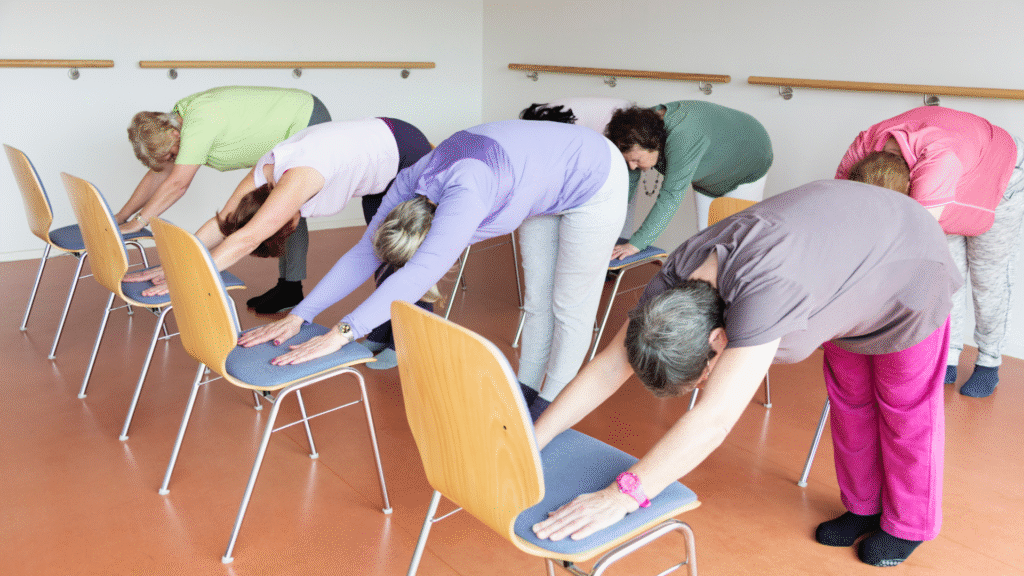
- Never force a stretch; move slowly and mindfully.
- Gentle tension is fine.
- Skip poses that feel uncomfortable.
Maintain Proper Alignment
- Sit tall with spine straight and shoulders relaxed.
- Feet hip-width apart, flat on the floor.
- For lower back support, engage your core lightly.
- Avoid leaning back too much.
Breathe with Awareness
- Inhale when opening the body.
- Exhale when folding, twisting, or releasing.
- To stay relaxed, use slow belly breathing.
Warm Up First
- Start with gentle neck rolls, shoulder shrugs, and ankle circles.
- To prepare body and mind, take a few deep breaths.
6. Step-by-Step Chair Yoga Poses to Improve Posture & Core Strength
Below are simple yet powerful poses you can try anytime.
1. Seated Mountain Pose
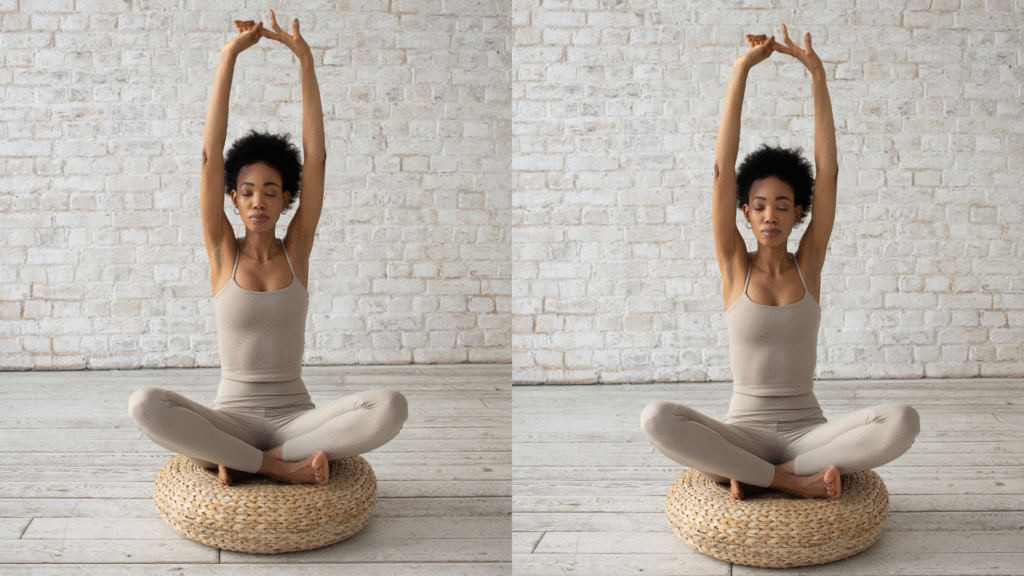
- Sit straight with your feet on the ground, hip-width apart.
- Roll your shoulders back, rest your hands on your thighs, and engage your core.
- Imagine from your head a string gently pulling you upward.
Benefits: Improves posture and strengthens spinal alignment.
2. Seated Cat-Cow Stretch

- Sit at the edge of your chair.
- Put your hands on your knees.
- Inhale, lift your chest, and arch your back (Cow Pose).
- Exhale, round your spine, and tuck your chin (Cat Pose).
Benefits: Enhances spinal flexibility and relieves tension.
3. Seated Forward Bend
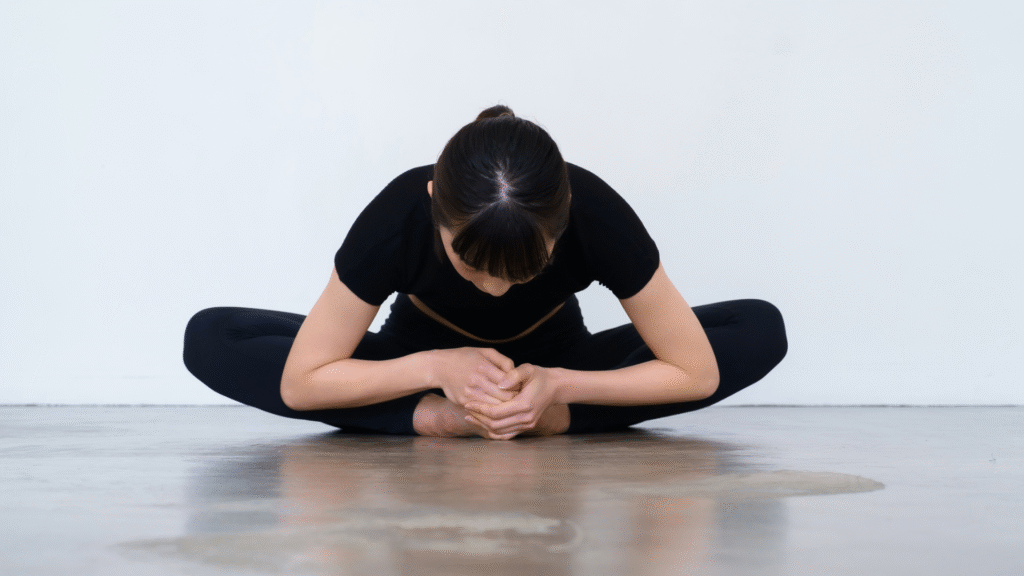
- In a seated position, slowly hinge forward from your hips.
- Let your arms loosely hang toward the floor.
- Breathe deeply and relax your neck.
Benefits: While calming the mind, it stretches the hamstrings, back, and shoulders.
4. Seated Spinal Twist
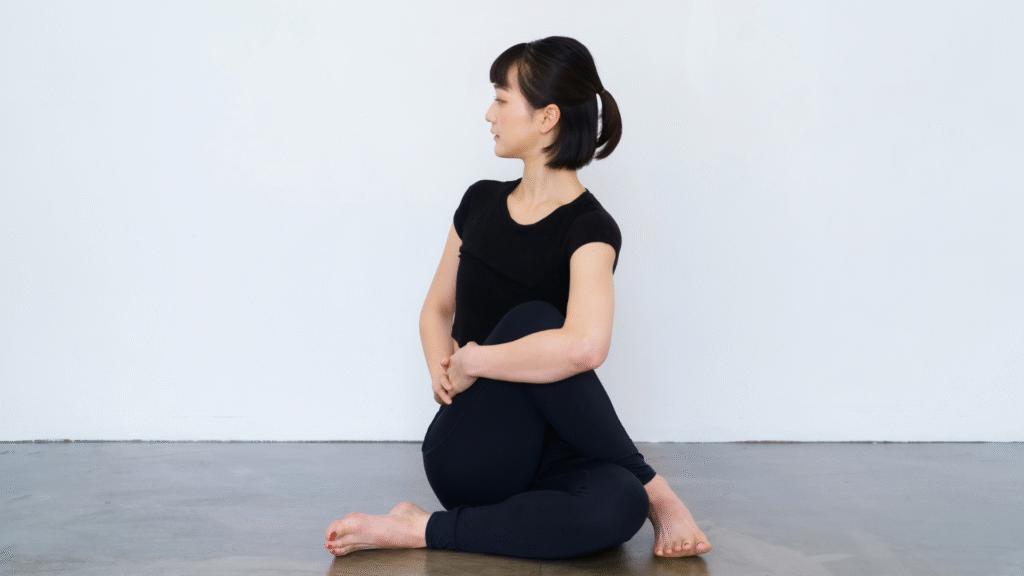
- Sit upright with both feet on the floor.
- Place your right hand on the chair’s back and your left hand on your thigh.
- First inhale, then exhale and twist gently to the right.
- Hold and repeat on the left.
Benefits: Aids digestion and improves spinal mobility.https://heathyhabit.online/
5. Seated Side Stretch
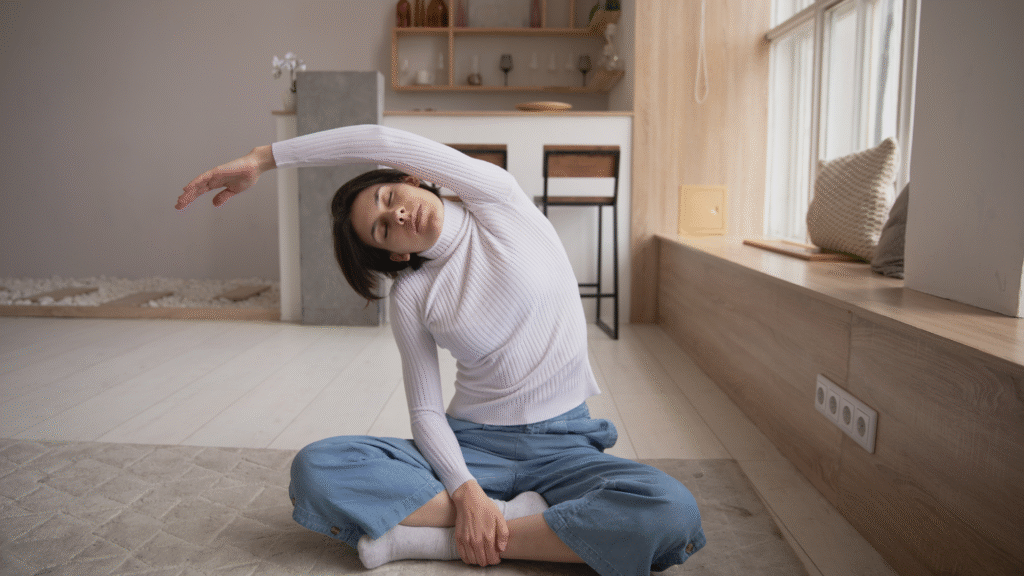
- Sit straight.
- Inhale, raise your right arm above your head.
- Exhale, gently lean to the left.
- Repeat on the other side.
Benefits: Stretches oblique muscles and improves the ability to move.
6. Seated Leg Lifts
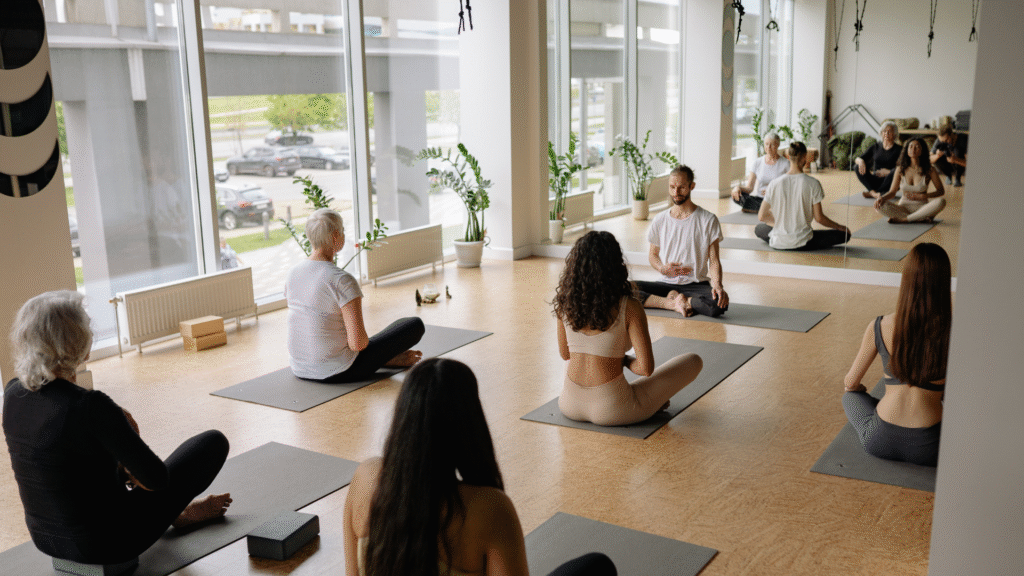
- Sit and hold the chair sides for support.
- Lift your right leg in a straight position and parallel to the floor.
- Hold for a few seconds, then lower slowly.
- Repeat with the left leg.
Benefits: Strengthens core and thigh muscles.
7. Seated Eagle Arms

- Sit upright, extend arms forward.
- Cross your right arm under the left, bending at the elbows.
- Try to bring your palms as close as possible.
- Lift elbows and breathe.
Benefits: Improves posture and opens shoulder joints.
8. Seated Warrior II Variation
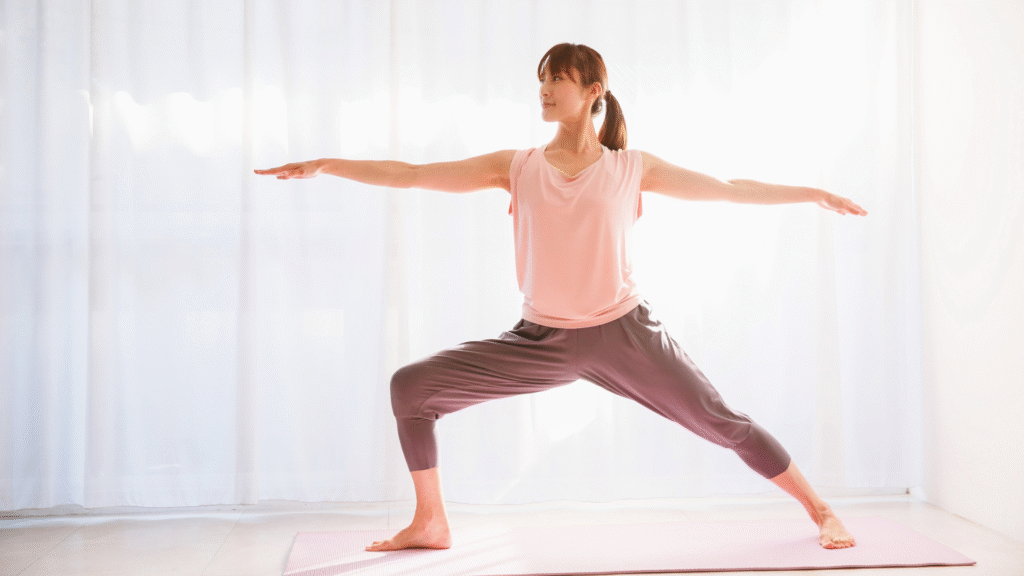
- With legs apart, sit sideways on your chair.
- Straighten your arms parallel to the floor.
- Keep one leg bent at 90 degrees and the other stretched behind you.
Benefits: Improves focus and builds strength in the legs, core.
9. Seated Bridge with Support
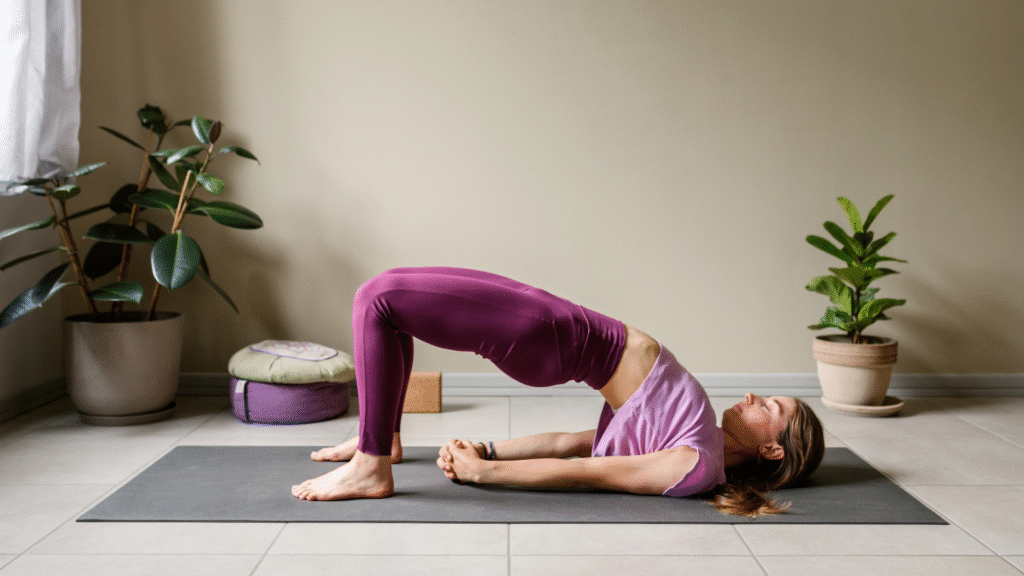
- Sit at the edge of your chair.
- For stability, place your hands on the seat.
- Press your feet on the ground and lift your hips slightly forward and upward.
Benefits: Strengthens glutes and core while opening the chest.
10. Relaxation & Breathing Exercise

- Sit, put your hands on your thighs.
- Close your eyes, inhale for 4 seconds, hold for 2, exhale for 6 seconds.
- Repeat for 5–10 breaths.
Benefits: Reduces stress, calms the nervous system.
7. How to Build a Simple Daily Routine with Chair Yoga
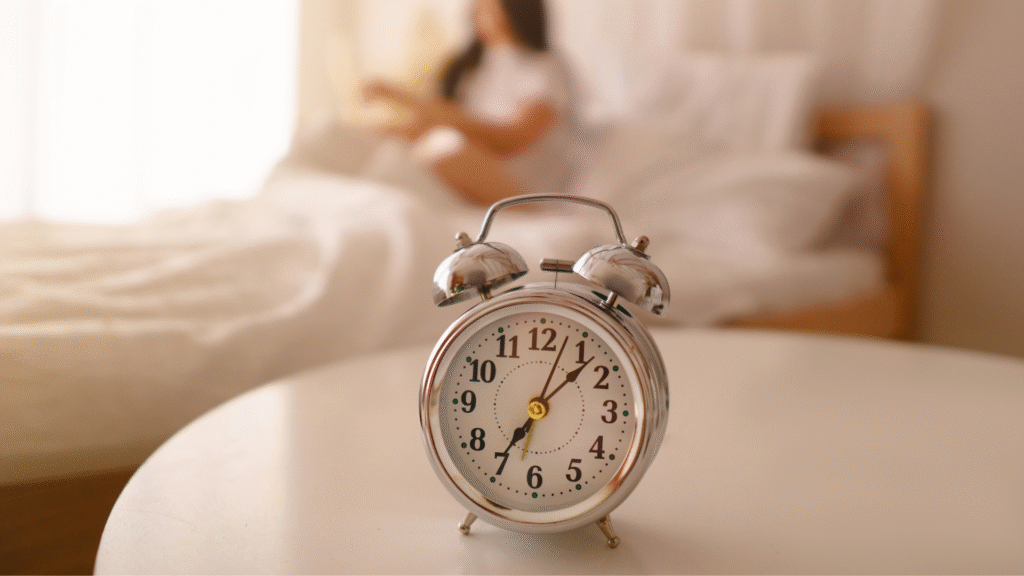
Start with 10–15 minutes; you don’t need to do all ten poses every day. Here’s a beginner-friendly sequence:
- Seated Mountain Pose – 1 minute (ground yourself)
- Cat-Cow Stretch – 5 breaths
- Side Stretch + Spinal Twist – 1 minute each side
- Leg Lifts – 10 repeats per leg
- Eagle Arms + Forward Bend – 1 minute each
- Breathing Exercise – 3–5 minutes
This routine can be done in the morning as well as the evening at your desk.
8. Real-Life Applications: Using Chair Yoga at Home, Office & Senior Centers
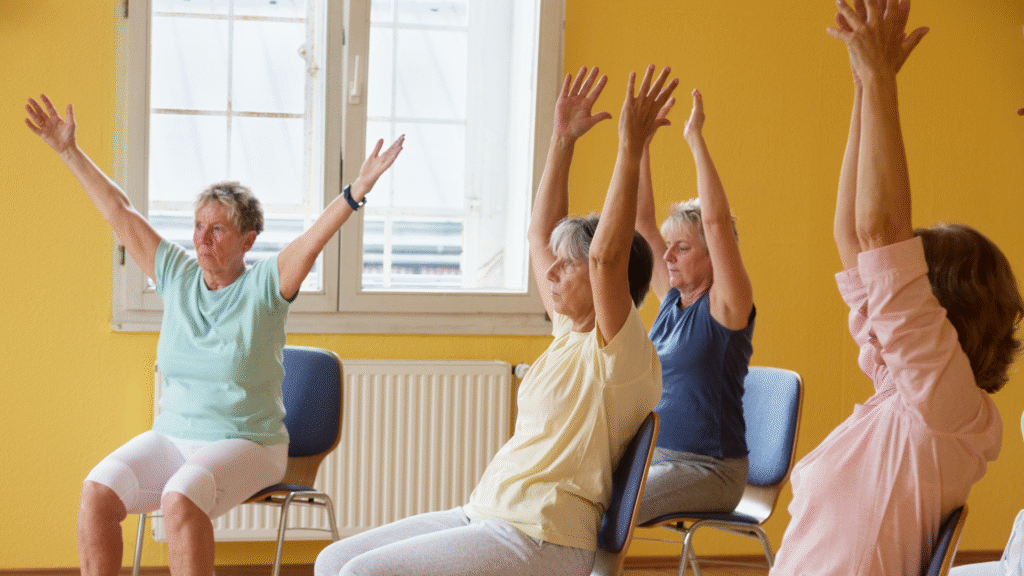
- At Home: When you don’t have time for a full workout, it is perfect for mornings or evenings. It’s also family-friendly, and anyone can join.
- At the Office: Good for little breaks to reduce stiffness, eye strain, and stress. A little stretching between meetings can reset your energy.
- At Senior Centers: For older adults, it provides safe movement, improves flexibility, and reduces fall risk.
9. Lifestyle Tips to Support Posture & Core Strength

If daily habits work against it, yoga alone will never fix posture. Here are some tips:
- Sit Smart: Keep both feet on the floor, shoulders relaxed, and avoid slouching.
- Take Breaks: Stand, stretch, and walk every 30–60 minutes.
- Strengthen Core Daily: 5 minutes of simple core exercises, such as seated leg lifts or planks, can make a difference.
- Stay Hydrated: Dehydration can cause muscle stiffness and fatigue.
- Mindful Breathing: To reset posture and calm your nervous system, do deep breathing throughout the day.
10. Common Mistakes to Avoid in Chair Yoga
If done incorrectly, even simple practices can be less effective or harmful. Avoid the following mistakes:
- Slouching in a chair can reduce core engagement.
- Forcing a stretch: it should be gentle, not painful.
- Holding breath: through movements, breathe steadily.
- Skipping warm-up: from gentle prep like shoulder rolls, chair yoga can be beneficial.
- Ignoring alignment: keep feet on the floor, spine straight, and shoulders relaxed.https://www.uaex.uada.edu/
Final Thought:
Chair yoga is more than exercise; it is a way to bring mindfulness, correct posture, and core strength into daily life. These simple poses offer an accessible path to better health, whether you’re at home, at work, or supporting seniors.
